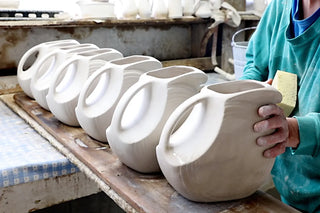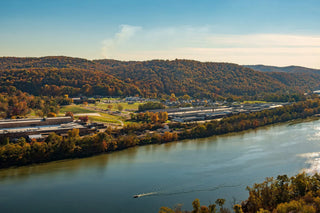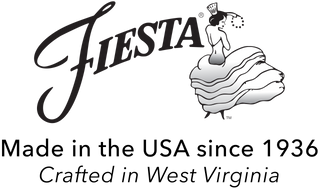Timeline History

1840s
The pottery industry in East Liverpool begins with manufacturing yellow ware from the rich deposits of local clay, utilizing the Ohio River to transport products throughout the region.
1870-1879
Public preference shifts to a more sophisticated white ware imported from England. East Liverpool City Council offered $5,000 in seed money to someone who would build and operate a pottery for production of white ware.
1871
The Laughlin Brothers (Homer and Shakespeare) form a partnership to sell pottery with the support of the East Liverpool city council. They build a two-kiln plant on the banks of the Ohio River to produce white ware as the alternative to yellow.
1877
Shakespeare pursues other interests; the business continues under Homer’s direction and becomes The Homer Laughlin China Works.

1880-1889
Homer Laughlin becomes one of the better-known manufacturers of ceramic dinnerware and toilet ware in the country. In 1889 a young bookkeeper from Steubenville, OH, William Edwin Wells, is hired to manage the books and eventually, the business.
1897-1899
Homer Laughlin retires and sells the business to Wells and a financial partner, Louis I. Aaron of Pittsburgh. Two more plants are built to support operations. Key customers contributing to the company's rapid growth are the F.W. Woolworth Company, the country's fastest growing variety (5 & 10 cent) store chain and the American Cereal Company of Chicago, who was packing oatmeal bowls in Mother's Oats boxes.

1902-1909
A tract of land on the opposite side of the Ohio River is purchased from the Newell family. A subsidiary company, the North American Manufacturing Company, is formed to develop the tract into the town of Newell. Lots are laid out, water and sewer systems are installed and electric power is secured. Just as vital is the suspension bridge built across the Ohio River, connecting the new community with East Liverpool. Plus, a trolley line is built to transport workers across the river. The largest pottery plant in the world at the time, plant 4, opens in 1906. Production hits 300,000 pieces per day, as the Homer Laughlin China Company represents 10% of the U. S. production capacity. The company officially moves its headquarters and operations to the Newell location.

1910-1914
Louis Aaron retires and is succeeded as president by his son, Marcus Aaron, as rapid growth continues. Plant No. 5 opens with 16 additionalkilns;totalling 78 for ware and 60 for decorating.
1917
W.E. Wells writes to the Woolworth Company “…this is the first time in history that the purchases of any one concern from any one pottery firm have reached the million mark in one year.”

1920-1928
The early 1920’s marked the most revolutionary change that had ever hit the pottery industry. The Homer Laughlin China Company replaces intermittent kilns with continuous firing tunnel kilns at plants 4 and 5 to increase production. New plants 6 and 7 open. Plants on the East End are phased out in favor of the largest Homer Laughlin China Company, plant 8. With 800 employees and a total capacity equal to 160 upright kilns, plant 8 focused making ware for Woolworth’s, at an average price of 72 cents per dozen. That amounts to 16.7 million pieces of ware sold to one customer in one year.
1927
Frederick HurtenRhead is hired as design director in 1927. Rhead's 15-year reign proved to be the most prolific period of new product introductions in the company's history. Rhead designed Virginia Rose as well as the several Eggshell shapes. Rhead's most noted accomplishment was Fiesta. Fiesta shapes were created in an Art Deco style with concentric circles highlighting the bright colors.

1930
W.E. Wells retires, and is replaced by his eldest son, Joseph M. Wells, Sr.
1936
With great fanfare, The Homer Laughlin China Company introduces Fiesta at the Pittsburgh China & Glass Show in January 1936. Shapes are created in an Art Deco style with concentric circles highlighting the bright colors. The color pallet includesred, yellow, cobalt blue, green and ivory.
1938
One million dozen pieces of Fiesta are produced.
1939
Automatic jiggering replaces hand jiggering, further revolutionizing production.

1940-1949
World War II begins. Homer Laughlin produces china for the armed forces, as post-war production peaks. The company employs 3,000 and produces over 10 million dozen pieces of ware.
1940
Marcus Aaron retires as president and is succeeded by his son, Marcus Lester Aaron (M. L. Aaron), who serves as president for 48 years.

1950-1959
The 1950s sees a large increase in imported dinnerware produced in countries with very low labor costs. This competition takes its toll on the American industry; many potteries do not survive the decade. The Homer Laughlin China Company’s management decides to shift its emphasis from consumer dinnerware to commercial ware for the hotel and restaurant trade, introducing the “Best China” brand of vitrified hotel china.
Fashion dictates a change in Fiesta’s color palette; softer pastels emerge.
In 1959 J.M. Wells, Sr. retires, turning over the management of the company to the third generation of his family, Joe Wells, Jr.

1960-1970
Color trends move back to brighter colors and Fiesta follows. The Homer Laughlin China Company continues its hospitality push.
1973
Fiesta retires after 37 years of production.
1980-1985
The company begins to produce lead-safe china for the hospitality industry, setting an industry standard as well as setting the stage for today’s Fiesta.
1983
Produced the last semi-vitrified supermarket promotion for Alpha Beta in California.

1986
Fiesta is reintroduced in March of 1986 as a vitrified body, lead-safe, in new updated colors: white, black, cobalt, rose and apricot.
Joe Wells, Jr., retires and is replaced as executive vice president by his son, Joe Wells, III.
Limited collections are produced in lilac and chartreuse. Sapphire is produced for 16 months exclusively for Bloomingdales and to local West Virginia retailers.
M.L. Aaron retires as president and is succeeded by his son, Marcus (Pete) Aaron, II. The company is now in the hands of both families’ fourth generations.

1997
The 500 millionth piece of Fiesta is produced. Five hundred numbered raspberry presentation bowls are produced to commemorate the event.
1998
Fifteen Raspberry Bowls are donated to three charity auctions held in the Newell/East Liverpool area in June and August of 1998. The $75,000 in proceeds of these auctions are donated to educational scholarship funds.

2000’s
As Fiesta begins to flourish in the retail sector and the Homer Laughlin China Company becomes a leading force in the foodservice china industry, the aging factories undergo many changes. From 2002-2005, state-of-the-art computerized kilns are installed throughout plants 6, 7 and 8. Much-needed new forming and glazing equipment is installed and a self-contained "plant within a plant" is built at plant 8. The Homer Laughlin China Company prepares to enter the new millennium as the industry leader in both the foodservice and retail businesses.
2002
Joe Wells III, and his sisters, Jean Wicks and Elizabeth McIlvain, purchase the Aaron’s stockholder interests. Joe Wells III, is elected president and chief executive officer.
2007
Fiesta makes the transition to a lifestyle brand with new items like bakeware, adding licensing partners in glassware, table linens, cutlery, gadgets and more.
2008
The Homer Laughlin China Company gears up for its 75th anniversary with a new item and color: a 3-Piece Baking Bowl Set in Marigold. The 75th anniversary series continues with the unveiling of a large oval serving platter in 2009 and a 2-Piece Prep Bowl set in 2010.

2010
The Homer Laughlin China Company purchases The Hall China Company in East Liverpool, OH to expand its food service and Fiesta production.
2011
The official 75th Anniversary year. The dinnerware collection is available in limited edition anniversary color, Marigold, as well as limited edition soup tureen.
2013
Elizabeth McIlvain succeeds her brother, Joe Wells III, as the new president of Homer Laughlin. After 50 years of service, Wells takes his father’s place as chairman of the board.
2016
Fiesta celebrates its 80th Anniversary and the Homer Laughlin China Company celebrates its 145th year.
2018
Mulberry is introduced as the 2018 new color, marking the 50th Fiesta color.

2020
The Homer Laughlin China Company takes a bold step and returns to its roots, focusing solely on manufacturing dinnerware for the home. The foodservice divisions and brand names of The Homer Laughlin China Company (HLC) and the Hall China Company are acquired by Steelite International. The Homer Laughlin China Company is renamed as The Fiesta Tableware Company.
2021
The Fiesta Tableware Company celebrates 150 Years of American Craftsmanship.
Fiesta celebrates its 85th Anniversary, bringing to market the Pedestal Cake Plate in Twilight, the new color of 2021






